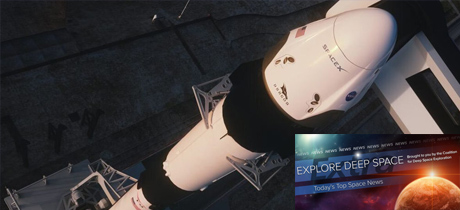In Today’s Deep Space Extra… NASA spacewalking astronauts Jessica Meir and Christina Koch complete the latest external battery upgrade on the International Space Station (ISS). NASA and SpaceX Commercial Crew test flight could be extended to increase Space Station crew in 2020. U.S. and China plan possible civil space dialogue in March.
Human Space Exploration
Third all-female spacewalk completes job of swapping out batteries
CBS News (1/20): NASA astronauts Jessica Meir and Christina Koch, who on October 18 conducted the first all-woman spacewalk, joined for a third excursion on Monday to complete a solar power system battery upgrade outside the International Space Station (ISS). Over five NASA spacewalks dating to October 6, the Space Station crew replaced a dozen aging nickel hydrogen batteries with six, smaller, and more efficient lithium ion batteries. It was the third of four campaigns to replace all 48 of the older nickel hydrogen batteries distributed across eight power channels on the Station’s long solar power truss to help extend the life of the six person orbiting science laboratory.
NASA considering extended Crew Dragon test flight to ISS
SpaceNews.com (1/19): NASA is assessing an option to extend Demo-2, SpaceX’s crewed test flight to the International Space Station (ISS), the next milestone in the company’s efforts to achieve certification from the agency’s Commercial Crew Program to conduct regularly scheduled missions to the Station with astronauts. The crewed test mission is to follow Sunday’s uncrewed Crew Dragon in-flight abort. In April, the Space Station — normally staffed by six to seven fliers — is to fall to just three, one veteran NASA astronaut and two freshman Russian cosmonauts, because of a cutback to two three person Soyuz launches annually and the absence of a U.S. human launch capability. Demo-2 could be ready to launch in the second quarter of 2020 with two NASA astronauts, whose relatively short stay at the Space Station could be extended to help maintain the pace of science activities and participate in spacewalk maintenance and upgrades.
The first all-woman Mars analog crew just ‘returned to Earth’ in Hawaii
Space.com (1/20): A six person, all woman two week Mars mission simulation in Hawaii ended as planned on Saturday. It was part of the Sensoria project, a series of mission simulations to be led by women and with a majority of female participants.
Space Science
Panchromatic astronomy on a budget
The Space Review (1/20): As January comes to a close, NASA intends to shut down the Spitzer Space Telescope, which was launched in August 2003. One of its final contributions to astronomy was the confirmation of a planet in the habitable zone of a red dwarf star about 100 light years from Earth. Spitzer will join the Compton Gamma Ray Observatory as the second of NASA’s Great Observatories to arrive at end of mission. The Hubble Space Telescope, continues to observe, though it will reach its 30th anniversary in April and is showing signs of age. The Chandra X-Ray Observatory marked its 20th anniversary last year. Compton re-entered the Earth’s atmosphere in June 2000 after a nine year mission. The astrophysics community is looking at a concept called the Next Great Observatories that would feature multi-spectral capabilities not present in the James Webb Space Telescope (JWST) and the Wide Field Infrared Space Telescope (WFIRST), both developed to observe in the infrared portion of the light spectrum. The challenge is whether the funding will be available for a second generation of “Greats” before Hubble and Chandra also expire.
China’s Chang’e-4 probe resumes work for 14th lunar day
Xinhuanet (1/20): China’s Chang’e 4 lander and rover reached the South Pole Aitken Basin at the south pole on the Moon’s far side on January 3, 2019. The Yutu-2 rover, designed to function just three months, continues to set the record for the longest lived lunar rover.
Op Eds
A national treasure turns 90
The Space Review (1/20): Buzz Aldrin marked his 90th birthday on Monday. “In recent years, Aldrin has, as much or more than any other astronaut I can think of, promoted human spaceflight,” writes Eric R. Hedman, chief technology officer at Logic Design, in a tribute. “What I continue to find inspiring is that at an age when most people are retired or no longer here, Buzz continues to look forward at what could be and pushes to help make it happen.”
Other News
U.S., China set for spring Civil Space Dialogue on exploration, science
SpaceNews.com (1/20): The U.S. State Department and NASA are currently working toward a meeting with China to discuss topics such as space exploration and science. Entitled the “U.S.-China Civil Space Dialogue”, this meeting will be a resumption of discussions originally begun in 2015. Despite a Congressional restriction on bilateral space endeavors between NASA and China, the two countries can cooperate provided that the FBI certifies there are no security risks and Congress is notified of the plan.

